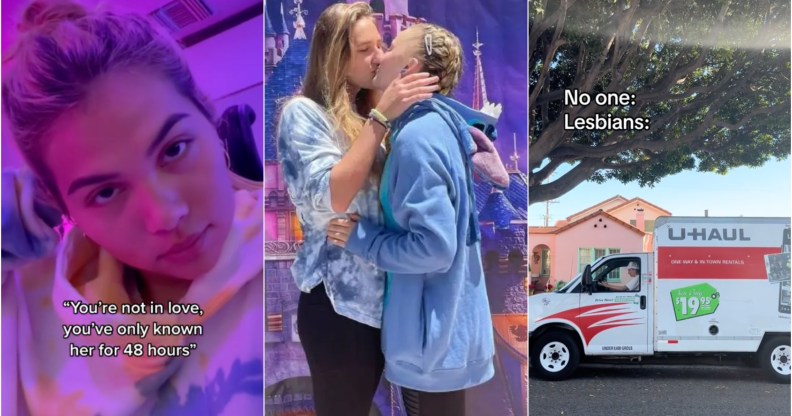Are you actually a ‘U-Haul lesbian’? Everything you need to know about the term

Hayley Kiyoko and Jojo Siwa have both joked that they’re U-Haul lesbians (TikTok: HayleyKiyoko / Instagram: ItsJojoSiwa)
In the catalogue of lesbian lingo, sandwiched between ‘pillow princess’ and ‘Hey Mamas’ is ‘U-Haul lesbian‘.
The term has become increasingly common and if you’ve heard it online or out and about and you’re not sure exactly what it means – we’ve got all the answers.
So, what does “U-Haul lesbian” mean?
“U-Haul lesbian” refers to a lesbian who moves in with their partner very soon (weeks, maybe even days) after they begin dating.
Even “lesbian Jesus” herself, Hayley Kiyoko, has made TikTok videos referencing the term.
Or, more generally: a lesbian who gets into relationships that move very quickly.
Depending on the context, “U-Haul lesbian” can be considered complimentary or funny, but just be warned: it is also potentially disparaging.
JoJo Siwa is a self-identifying “U-Haul lesbian” after she revealed she lived with two romantic partners.
The Dance Moms alum admitted that the experience was “a lot” on her podcast JoJo Siwa Now.
“I love it when it’s in the honeymoon phase. But then all of a sudden I’m like: ‘Oh my God, I’m 17 and married,’ you know what I mean?” she said of her experience.
“It feels wrong, and it feels like she wasn’t living her life, and I wasn’t living my life. We were only trying to live together. You’re so young, and you have so much to do.”
Where does the term “U-Haul lesbian” come from?
Referencing the American moving truck company U-Haul (a brand of rental “move-it-yourself” trucks), the playful term “U-Haul lesbian” has been around longer than you may think.
The mainstream introduction of “U-Haul lesbian” is often attributed to American comedian and jazz singer Lea DeLaria, best known for Orange is the New Black.
In DeLaria’s 1997 comedy album, Box Lunch (which she wrote in 1989), she calls out to the audience “What does a lesbian bring on a second date?”
The crowd would then respond: “A U-Haul.”
Though DeLaria’s shot the reference into the wider mainstream, the fact the audience already knew the punchline implies that the punchline was already well-known in the LGBTQ+ community at the time of recording.
Is there any science behind the “U-Haul lesbian” phenomenon?
Though the “U-Haul lesbian” term has proliferated through the lesbian community, is there any real scientific backing that suggests lesbians are more likely to move in together quicker than anyone else? Like so many LGBTQ+ concepts, the answer is… it’s complicated.
Psychologist Christopher J Alexander noted that “U-Haul syndrome” epitomises the perceived stereotype of quickly forming intense emotional connections. This is referred to as the “urge to merge” in gay slang.
In 2013, an article in The Atlantic theorised that the stereotype has a historical underpinning based on safety.
In the 1950s and 1960s, lesbian couples were pushed to the margins of society where they created their own partnerships and communities. Therefore, it was much easier and more practical to then live together.
Though these musings are compelling, a 2018 study from Stanford University reported that lesbians are not more likely to commit to living together quicker than any other group.
The report concludes: “Contrary to popular conceptions of lesbians as eager to commit, our results indicate that after controlling for couple age there are no significant differences in relative rates of cohabitation among couple types.”
Though this Stanford study may say otherwise, there is plenty of anecdotal evidence to suggest the “U-Haul lesbian” term holds truth for some.
At the end of the day, it is personal to you and you should do whatever feels right. After all, there is no ‘too quick’ or ‘too slow’ timeline for each different queer relationship.

